Practical Assessment of HLTINF001: Infection Control Procedures
VerifiedAdded on 2022/11/23
|90
|17337
|237
Practical Assignment
AI Summary
This document is an Assessor Pack for the practical assessment of the HLTINF001 unit, which focuses on complying with infection prevention and control policies and procedures. It outlines the skills and knowledge required for students to demonstrate competence, including assessment criteria and benchmark answers. The pack includes information on assessment tasks, such as simulated workplace tasks, risk management, and environmental cleaning, along with instructions for students and supervisors. It also provides guidelines on gathering third-party evidence, giving feedback, and assessor instructions. The assessment involves tasks like following hand hygiene practices, adhering to organizational guidelines, and using appropriate facilities and equipment. The document emphasizes the importance of professional standards, codes, and guidelines, and provides links to relevant resources. Assessors are instructed to use observation checklists and supervisor declarations to evaluate student performance, ensuring that all assessment tasks are completed satisfactorily. The document also highlights the importance of constructive, timely, and meaningful feedback for students to improve their learning and performance. This resource is designed to guide both assessors and students through the practical assessment process, ensuring a comprehensive evaluation of competence in infection prevention and control.
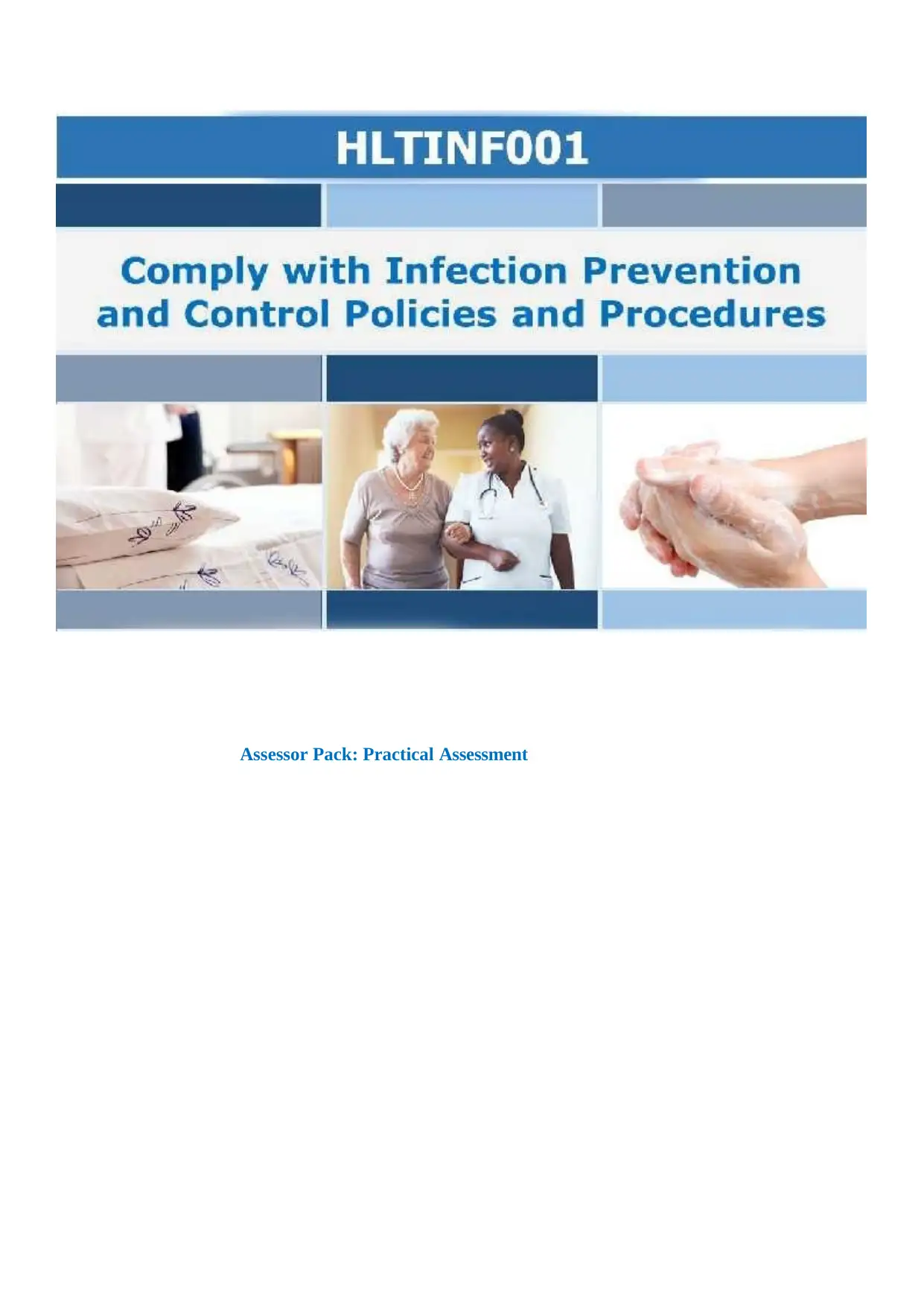
Assessor Pack: Practical Assessment
Paraphrase This Document
Need a fresh take? Get an instant paraphrase of this document with our AI Paraphraser
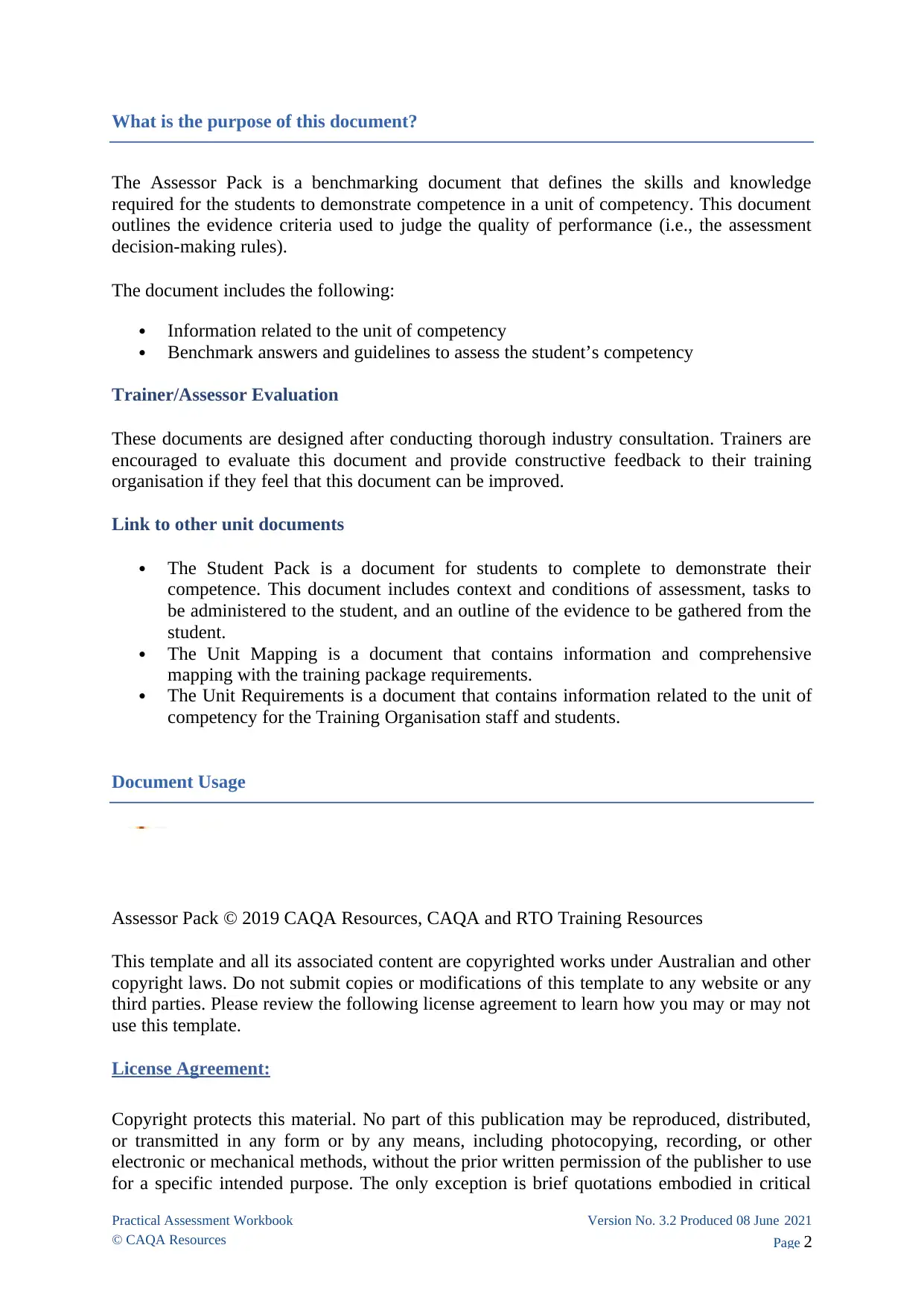
Practical Assessment Workbook
© CAQA Resources
Version No. 3.2 Produced 08 June 2021
Page 2
What is the purpose of this document?
The Assessor Pack is a benchmarking document that defines the skills and knowledge
required for the students to demonstrate competence in a unit of competency. This document
outlines the evidence criteria used to judge the quality of performance (i.e., the assessment
decision-making rules).
The document includes the following:
Information related to the unit of competency
Benchmark answers and guidelines to assess the student’s competency
Trainer/Assessor Evaluation
These documents are designed after conducting thorough industry consultation. Trainers are
encouraged to evaluate this document and provide constructive feedback to their training
organisation if they feel that this document can be improved.
Link to other unit documents
The Student Pack is a document for students to complete to demonstrate their
competence. This document includes context and conditions of assessment, tasks to
be administered to the student, and an outline of the evidence to be gathered from the
student.
The Unit Mapping is a document that contains information and comprehensive
mapping with the training package requirements.
The Unit Requirements is a document that contains information related to the unit of
competency for the Training Organisation staff and students.
Document Usage
Assessor Pack © 2019 CAQA Resources, CAQA and RTO Training Resources
This template and all its associated content are copyrighted works under Australian and other
copyright laws. Do not submit copies or modifications of this template to any website or any
third parties. Please review the following license agreement to learn how you may or may not
use this template.
License Agreement:
Copyright protects this material. No part of this publication may be reproduced, distributed,
or transmitted in any form or by any means, including photocopying, recording, or other
electronic or mechanical methods, without the prior written permission of the publisher to use
for a specific intended purpose. The only exception is brief quotations embodied in critical
© CAQA Resources
Version No. 3.2 Produced 08 June 2021
Page 2
What is the purpose of this document?
The Assessor Pack is a benchmarking document that defines the skills and knowledge
required for the students to demonstrate competence in a unit of competency. This document
outlines the evidence criteria used to judge the quality of performance (i.e., the assessment
decision-making rules).
The document includes the following:
Information related to the unit of competency
Benchmark answers and guidelines to assess the student’s competency
Trainer/Assessor Evaluation
These documents are designed after conducting thorough industry consultation. Trainers are
encouraged to evaluate this document and provide constructive feedback to their training
organisation if they feel that this document can be improved.
Link to other unit documents
The Student Pack is a document for students to complete to demonstrate their
competence. This document includes context and conditions of assessment, tasks to
be administered to the student, and an outline of the evidence to be gathered from the
student.
The Unit Mapping is a document that contains information and comprehensive
mapping with the training package requirements.
The Unit Requirements is a document that contains information related to the unit of
competency for the Training Organisation staff and students.
Document Usage
Assessor Pack © 2019 CAQA Resources, CAQA and RTO Training Resources
This template and all its associated content are copyrighted works under Australian and other
copyright laws. Do not submit copies or modifications of this template to any website or any
third parties. Please review the following license agreement to learn how you may or may not
use this template.
License Agreement:
Copyright protects this material. No part of this publication may be reproduced, distributed,
or transmitted in any form or by any means, including photocopying, recording, or other
electronic or mechanical methods, without the prior written permission of the publisher to use
for a specific intended purpose. The only exception is brief quotations embodied in critical
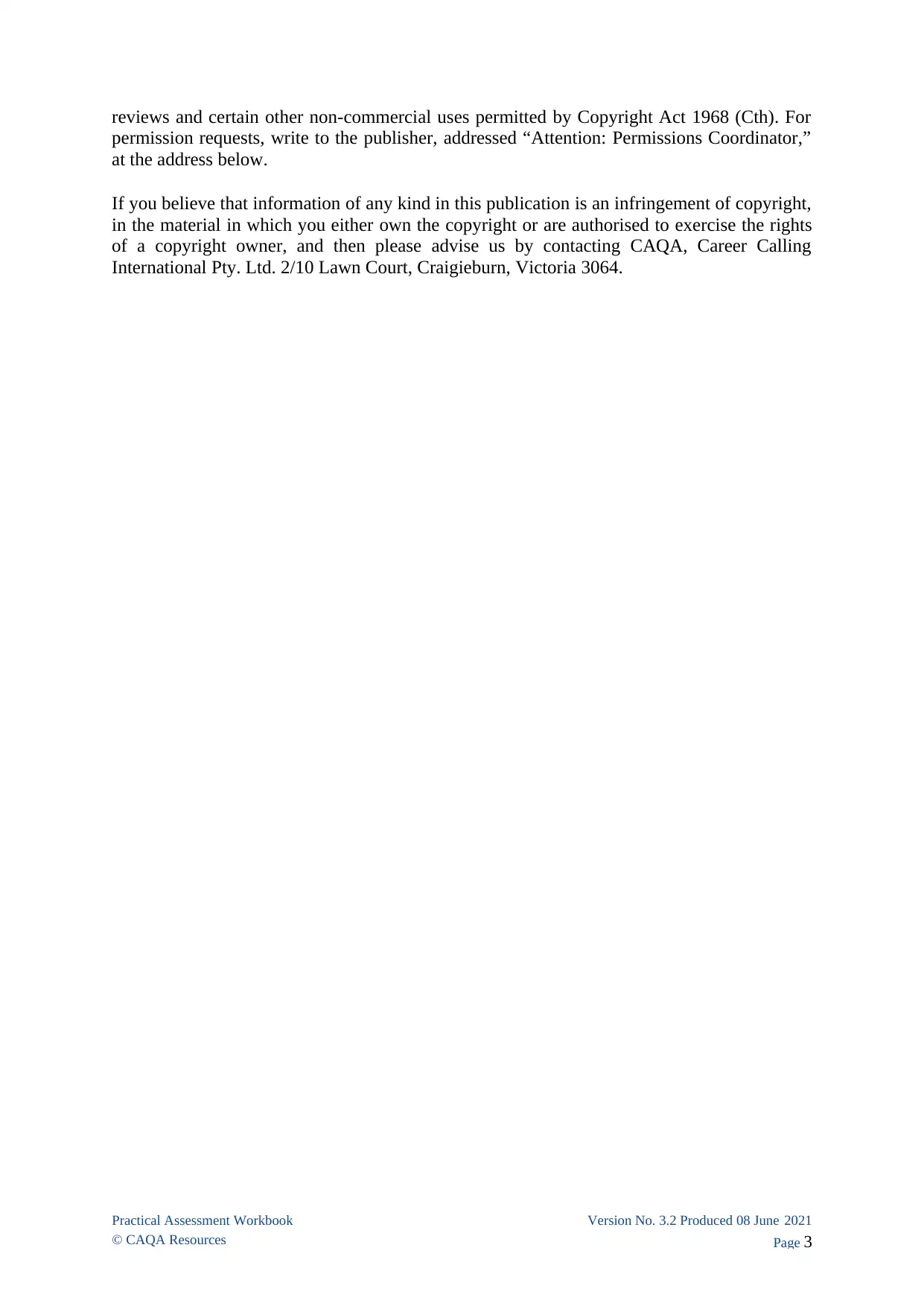
Practical Assessment Workbook
© CAQA Resources
Version No. 3.2 Produced 08 June 2021
Page 3
reviews and certain other non-commercial uses permitted by Copyright Act 1968 (Cth). For
permission requests, write to the publisher, addressed “Attention: Permissions Coordinator,”
at the address below.
If you believe that information of any kind in this publication is an infringement of copyright,
in the material in which you either own the copyright or are authorised to exercise the rights
of a copyright owner, and then please advise us by contacting CAQA, Career Calling
International Pty. Ltd. 2/10 Lawn Court, Craigieburn, Victoria 3064.
© CAQA Resources
Version No. 3.2 Produced 08 June 2021
Page 3
reviews and certain other non-commercial uses permitted by Copyright Act 1968 (Cth). For
permission requests, write to the publisher, addressed “Attention: Permissions Coordinator,”
at the address below.
If you believe that information of any kind in this publication is an infringement of copyright,
in the material in which you either own the copyright or are authorised to exercise the rights
of a copyright owner, and then please advise us by contacting CAQA, Career Calling
International Pty. Ltd. 2/10 Lawn Court, Craigieburn, Victoria 3064.
⊘ This is a preview!⊘
Do you want full access?
Subscribe today to unlock all pages.

Trusted by 1+ million students worldwide
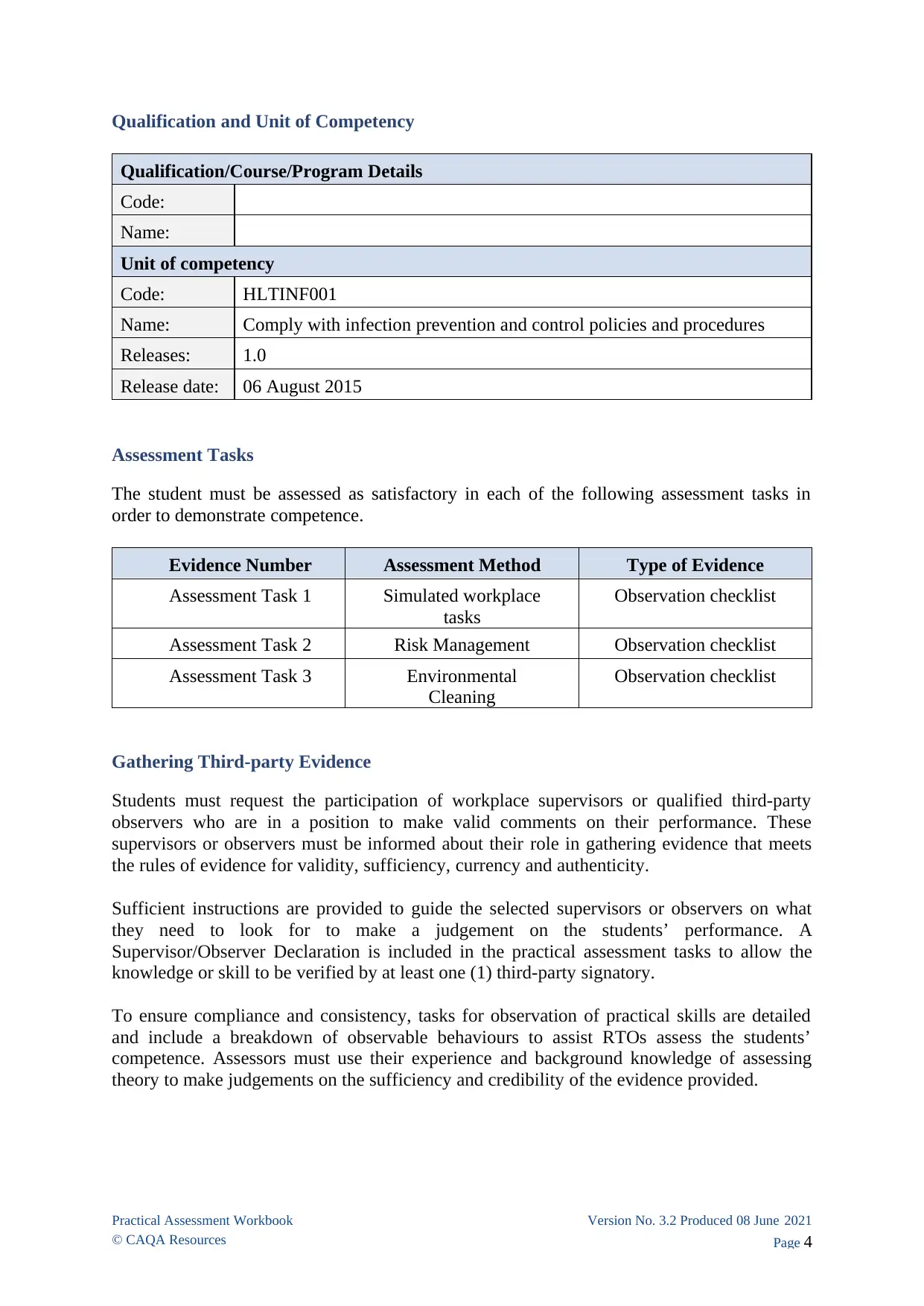
Practical Assessment Workbook
© CAQA Resources
Version No. 3.2 Produced 08 June 2021
Page 4
Qualification and Unit of Competency
Qualification/Course/Program Details
Code:
Name:
Unit of competency
Code: HLTINF001
Name: Comply with infection prevention and control policies and procedures
Releases: 1.0
Release date: 06 August 2015
Assessment Tasks
The student must be assessed as satisfactory in each of the following assessment tasks in
order to demonstrate competence.
Evidence Number Assessment Method Type of Evidence
Assessment Task 1 Simulated workplace
tasks
Observation checklist
Assessment Task 2 Risk Management Observation checklist
Assessment Task 3 Environmental
Cleaning
Observation checklist
Gathering Third-party Evidence
Students must request the participation of workplace supervisors or qualified third-party
observers who are in a position to make valid comments on their performance. These
supervisors or observers must be informed about their role in gathering evidence that meets
the rules of evidence for validity, sufficiency, currency and authenticity.
Sufficient instructions are provided to guide the selected supervisors or observers on what
they need to look for to make a judgement on the students’ performance. A
Supervisor/Observer Declaration is included in the practical assessment tasks to allow the
knowledge or skill to be verified by at least one (1) third-party signatory.
To ensure compliance and consistency, tasks for observation of practical skills are detailed
and include a breakdown of observable behaviours to assist RTOs assess the students’
competence. Assessors must use their experience and background knowledge of assessing
theory to make judgements on the sufficiency and credibility of the evidence provided.
© CAQA Resources
Version No. 3.2 Produced 08 June 2021
Page 4
Qualification and Unit of Competency
Qualification/Course/Program Details
Code:
Name:
Unit of competency
Code: HLTINF001
Name: Comply with infection prevention and control policies and procedures
Releases: 1.0
Release date: 06 August 2015
Assessment Tasks
The student must be assessed as satisfactory in each of the following assessment tasks in
order to demonstrate competence.
Evidence Number Assessment Method Type of Evidence
Assessment Task 1 Simulated workplace
tasks
Observation checklist
Assessment Task 2 Risk Management Observation checklist
Assessment Task 3 Environmental
Cleaning
Observation checklist
Gathering Third-party Evidence
Students must request the participation of workplace supervisors or qualified third-party
observers who are in a position to make valid comments on their performance. These
supervisors or observers must be informed about their role in gathering evidence that meets
the rules of evidence for validity, sufficiency, currency and authenticity.
Sufficient instructions are provided to guide the selected supervisors or observers on what
they need to look for to make a judgement on the students’ performance. A
Supervisor/Observer Declaration is included in the practical assessment tasks to allow the
knowledge or skill to be verified by at least one (1) third-party signatory.
To ensure compliance and consistency, tasks for observation of practical skills are detailed
and include a breakdown of observable behaviours to assist RTOs assess the students’
competence. Assessors must use their experience and background knowledge of assessing
theory to make judgements on the sufficiency and credibility of the evidence provided.
Paraphrase This Document
Need a fresh take? Get an instant paraphrase of this document with our AI Paraphraser
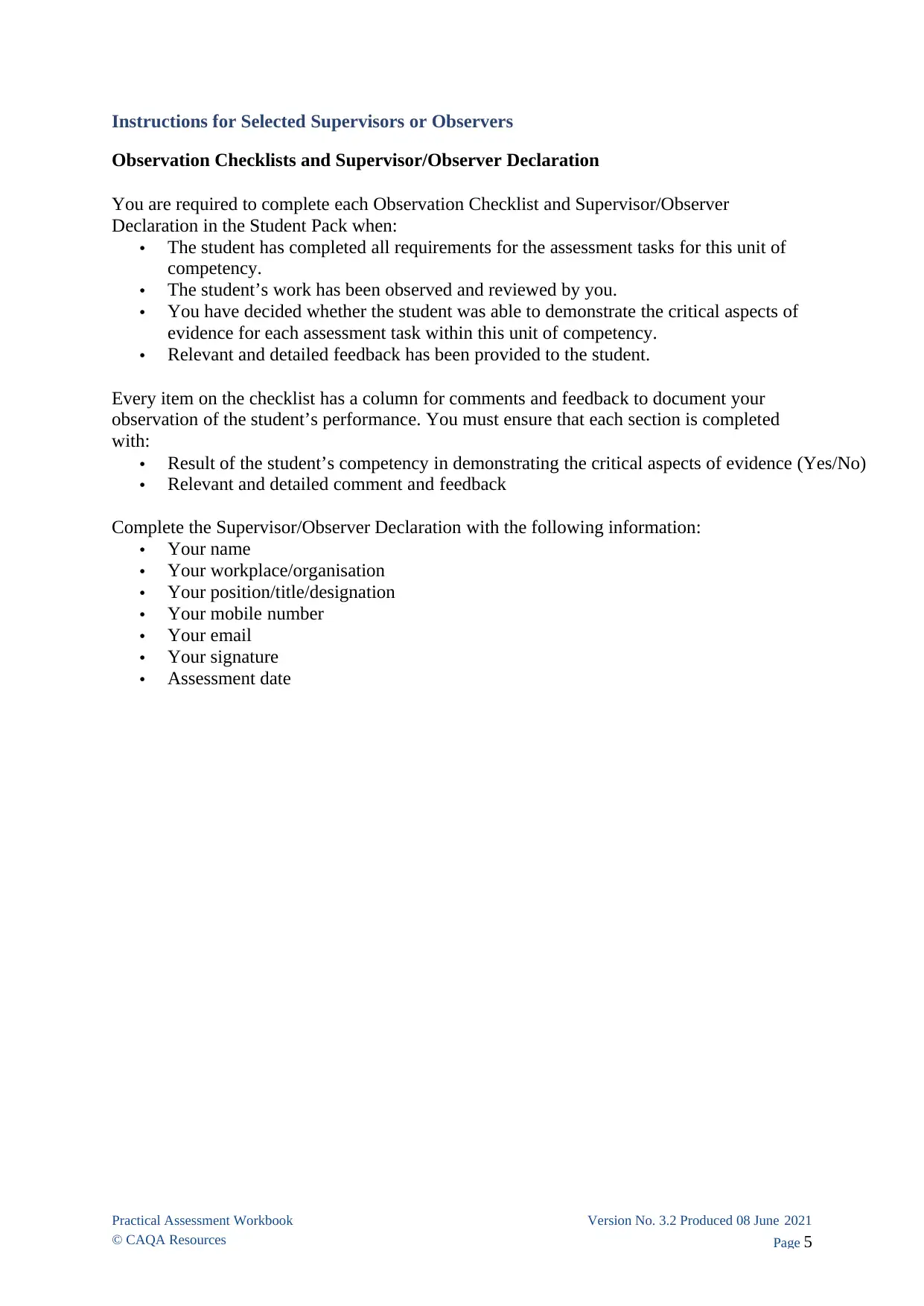
Practical Assessment Workbook
© CAQA Resources
Version No. 3.2 Produced 08 June 2021
Page 5
Instructions for Selected Supervisors or Observers
Observation Checklists and Supervisor/Observer Declaration
You are required to complete each Observation Checklist and Supervisor/Observer
Declaration in the Student Pack when:
• The student has completed all requirements for the assessment tasks for this unit of
competency.
• The student’s work has been observed and reviewed by you.
• You have decided whether the student was able to demonstrate the critical aspects of
evidence for each assessment task within this unit of competency.
• Relevant and detailed feedback has been provided to the student.
Every item on the checklist has a column for comments and feedback to document your
observation of the student’s performance. You must ensure that each section is completed
with:
• Result of the student’s competency in demonstrating the critical aspects of evidence (Yes/No)
• Relevant and detailed comment and feedback
Complete the Supervisor/Observer Declaration with the following information:
• Your name
• Your workplace/organisation
• Your position/title/designation
• Your mobile number
• Your email
• Your signature
• Assessment date
© CAQA Resources
Version No. 3.2 Produced 08 June 2021
Page 5
Instructions for Selected Supervisors or Observers
Observation Checklists and Supervisor/Observer Declaration
You are required to complete each Observation Checklist and Supervisor/Observer
Declaration in the Student Pack when:
• The student has completed all requirements for the assessment tasks for this unit of
competency.
• The student’s work has been observed and reviewed by you.
• You have decided whether the student was able to demonstrate the critical aspects of
evidence for each assessment task within this unit of competency.
• Relevant and detailed feedback has been provided to the student.
Every item on the checklist has a column for comments and feedback to document your
observation of the student’s performance. You must ensure that each section is completed
with:
• Result of the student’s competency in demonstrating the critical aspects of evidence (Yes/No)
• Relevant and detailed comment and feedback
Complete the Supervisor/Observer Declaration with the following information:
• Your name
• Your workplace/organisation
• Your position/title/designation
• Your mobile number
• Your email
• Your signature
• Assessment date
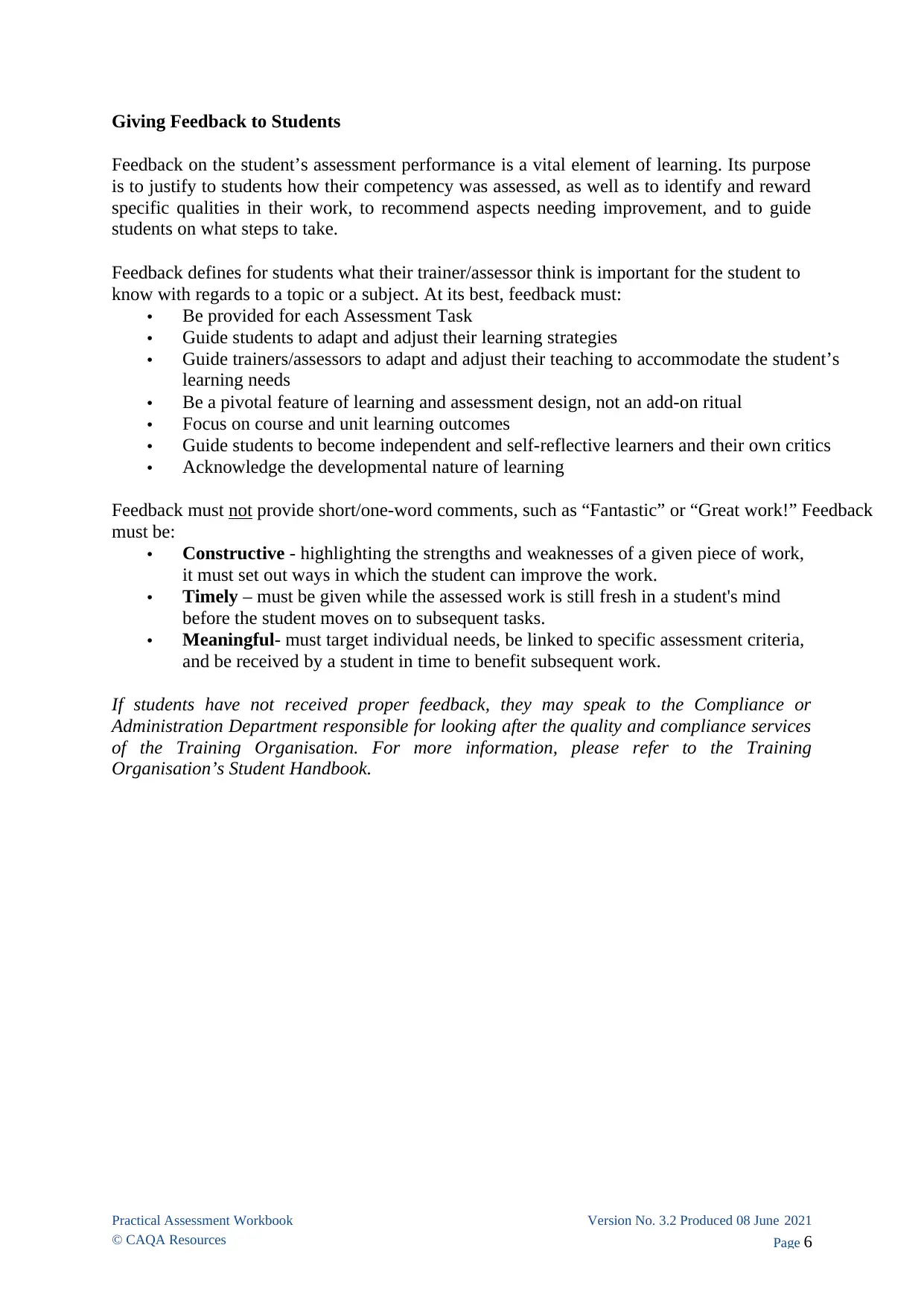
Practical Assessment Workbook
© CAQA Resources
Version No. 3.2 Produced 08 June 2021
Page 6
Giving Feedback to Students
Feedback on the student’s assessment performance is a vital element of learning. Its purpose
is to justify to students how their competency was assessed, as well as to identify and reward
specific qualities in their work, to recommend aspects needing improvement, and to guide
students on what steps to take.
Feedback defines for students what their trainer/assessor think is important for the student to
know with regards to a topic or a subject. At its best, feedback must:
• Be provided for each Assessment Task
• Guide students to adapt and adjust their learning strategies
• Guide trainers/assessors to adapt and adjust their teaching to accommodate the student’s
learning needs
• Be a pivotal feature of learning and assessment design, not an add-on ritual
• Focus on course and unit learning outcomes
• Guide students to become independent and self-reflective learners and their own critics
• Acknowledge the developmental nature of learning
Feedback must not provide short/one-word comments, such as “Fantastic” or “Great work!” Feedback
must be:
• Constructive - highlighting the strengths and weaknesses of a given piece of work,
it must set out ways in which the student can improve the work.
• Timely – must be given while the assessed work is still fresh in a student's mind
before the student moves on to subsequent tasks.
• Meaningful- must target individual needs, be linked to specific assessment criteria,
and be received by a student in time to benefit subsequent work.
If students have not received proper feedback, they may speak to the Compliance or
Administration Department responsible for looking after the quality and compliance services
of the Training Organisation. For more information, please refer to the Training
Organisation’s Student Handbook.
© CAQA Resources
Version No. 3.2 Produced 08 June 2021
Page 6
Giving Feedback to Students
Feedback on the student’s assessment performance is a vital element of learning. Its purpose
is to justify to students how their competency was assessed, as well as to identify and reward
specific qualities in their work, to recommend aspects needing improvement, and to guide
students on what steps to take.
Feedback defines for students what their trainer/assessor think is important for the student to
know with regards to a topic or a subject. At its best, feedback must:
• Be provided for each Assessment Task
• Guide students to adapt and adjust their learning strategies
• Guide trainers/assessors to adapt and adjust their teaching to accommodate the student’s
learning needs
• Be a pivotal feature of learning and assessment design, not an add-on ritual
• Focus on course and unit learning outcomes
• Guide students to become independent and self-reflective learners and their own critics
• Acknowledge the developmental nature of learning
Feedback must not provide short/one-word comments, such as “Fantastic” or “Great work!” Feedback
must be:
• Constructive - highlighting the strengths and weaknesses of a given piece of work,
it must set out ways in which the student can improve the work.
• Timely – must be given while the assessed work is still fresh in a student's mind
before the student moves on to subsequent tasks.
• Meaningful- must target individual needs, be linked to specific assessment criteria,
and be received by a student in time to benefit subsequent work.
If students have not received proper feedback, they may speak to the Compliance or
Administration Department responsible for looking after the quality and compliance services
of the Training Organisation. For more information, please refer to the Training
Organisation’s Student Handbook.
⊘ This is a preview!⊘
Do you want full access?
Subscribe today to unlock all pages.

Trusted by 1+ million students worldwide
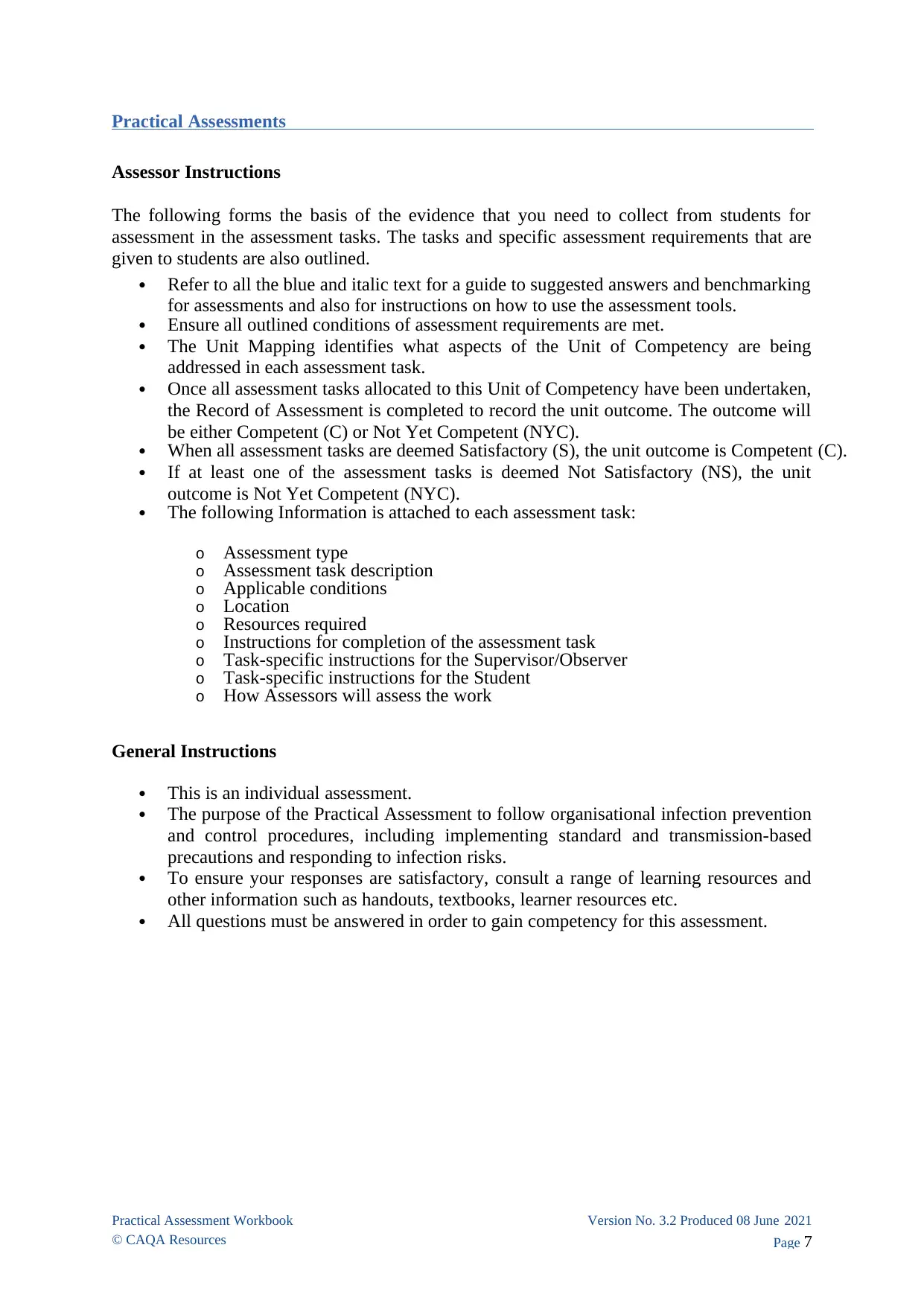
Practical Assessment Workbook
© CAQA Resources
Version No. 3.2 Produced 08 June 2021
Page 7
Practical Assessments
Assessor Instructions
The following forms the basis of the evidence that you need to collect from students for
assessment in the assessment tasks. The tasks and specific assessment requirements that are
given to students are also outlined.
Refer to all the blue and italic text for a guide to suggested answers and benchmarking
for assessments and also for instructions on how to use the assessment tools.
Ensure all outlined conditions of assessment requirements are met.
The Unit Mapping identifies what aspects of the Unit of Competency are being
addressed in each assessment task.
Once all assessment tasks allocated to this Unit of Competency have been undertaken,
the Record of Assessment is completed to record the unit outcome. The outcome will
be either Competent (C) or Not Yet Competent (NYC).
When all assessment tasks are deemed Satisfactory (S), the unit outcome is Competent (C).
If at least one of the assessment tasks is deemed Not Satisfactory (NS), the unit
outcome is Not Yet Competent (NYC).
The following Information is attached to each assessment task:
o Assessment type
o Assessment task description
o Applicable conditions
o Location
o Resources required
o Instructions for completion of the assessment task
o Task-specific instructions for the Supervisor/Observer
o Task-specific instructions for the Student
o How Assessors will assess the work
General Instructions
This is an individual assessment.
The purpose of the Practical Assessment to follow organisational infection prevention
and control procedures, including implementing standard and transmission-based
precautions and responding to infection risks.
To ensure your responses are satisfactory, consult a range of learning resources and
other information such as handouts, textbooks, learner resources etc.
All questions must be answered in order to gain competency for this assessment.
© CAQA Resources
Version No. 3.2 Produced 08 June 2021
Page 7
Practical Assessments
Assessor Instructions
The following forms the basis of the evidence that you need to collect from students for
assessment in the assessment tasks. The tasks and specific assessment requirements that are
given to students are also outlined.
Refer to all the blue and italic text for a guide to suggested answers and benchmarking
for assessments and also for instructions on how to use the assessment tools.
Ensure all outlined conditions of assessment requirements are met.
The Unit Mapping identifies what aspects of the Unit of Competency are being
addressed in each assessment task.
Once all assessment tasks allocated to this Unit of Competency have been undertaken,
the Record of Assessment is completed to record the unit outcome. The outcome will
be either Competent (C) or Not Yet Competent (NYC).
When all assessment tasks are deemed Satisfactory (S), the unit outcome is Competent (C).
If at least one of the assessment tasks is deemed Not Satisfactory (NS), the unit
outcome is Not Yet Competent (NYC).
The following Information is attached to each assessment task:
o Assessment type
o Assessment task description
o Applicable conditions
o Location
o Resources required
o Instructions for completion of the assessment task
o Task-specific instructions for the Supervisor/Observer
o Task-specific instructions for the Student
o How Assessors will assess the work
General Instructions
This is an individual assessment.
The purpose of the Practical Assessment to follow organisational infection prevention
and control procedures, including implementing standard and transmission-based
precautions and responding to infection risks.
To ensure your responses are satisfactory, consult a range of learning resources and
other information such as handouts, textbooks, learner resources etc.
All questions must be answered in order to gain competency for this assessment.
Paraphrase This Document
Need a fresh take? Get an instant paraphrase of this document with our AI Paraphraser
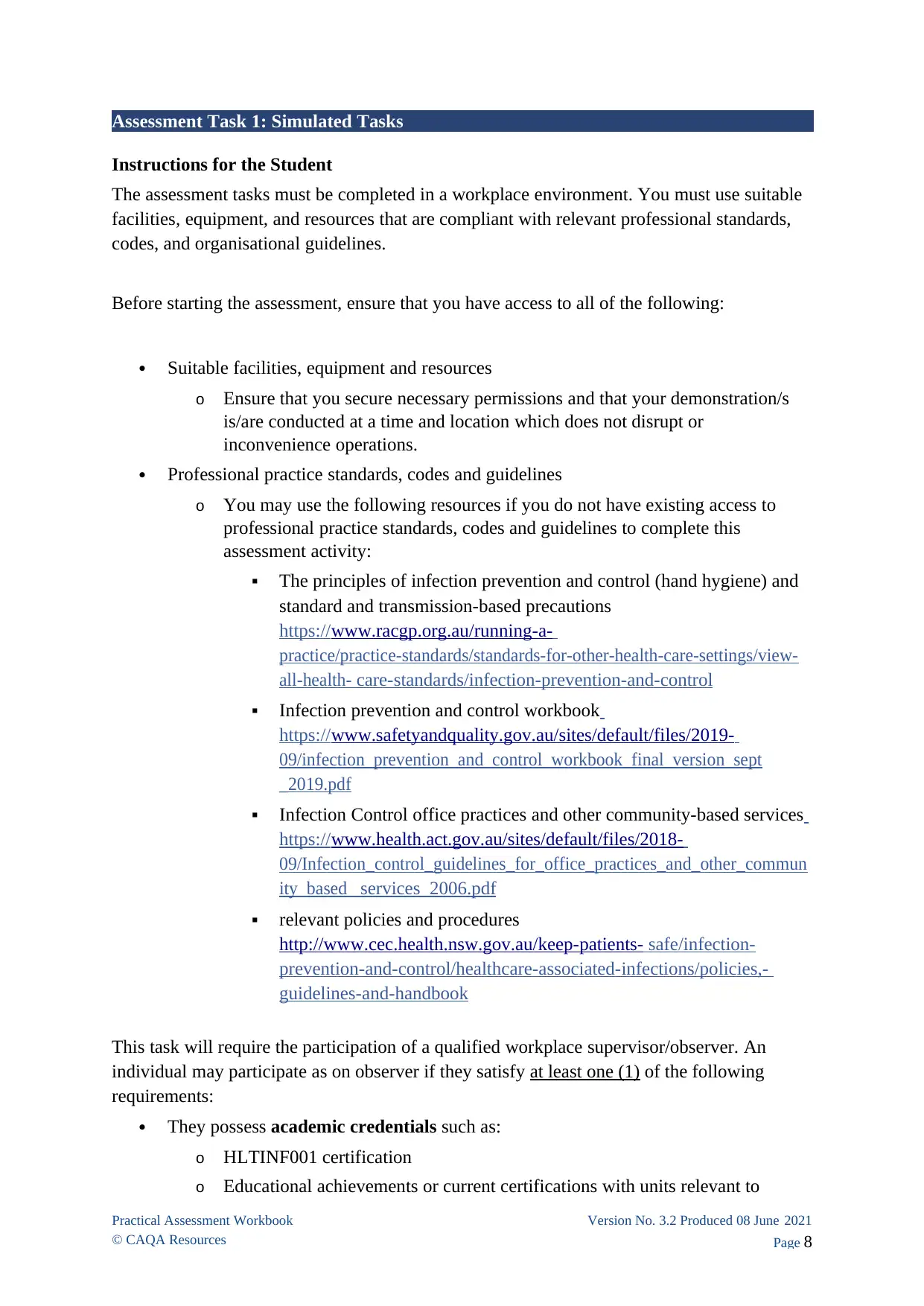
Practical Assessment Workbook
© CAQA Resources
Version No. 3.2 Produced 08 June 2021
Page 8
Assessment Task 1: Simulated Tasks
Instructions for the Student
The assessment tasks must be completed in a workplace environment. You must use suitable
facilities, equipment, and resources that are compliant with relevant professional standards,
codes, and organisational guidelines.
Before starting the assessment, ensure that you have access to all of the following:
Suitable facilities, equipment and resources
o Ensure that you secure necessary permissions and that your demonstration/s
is/are conducted at a time and location which does not disrupt or
inconvenience operations.
Professional practice standards, codes and guidelines
o You may use the following resources if you do not have existing access to
professional practice standards, codes and guidelines to complete this
assessment activity:
The principles of infection prevention and control (hand hygiene) and
standard and transmission-based precautions
https://www.racgp.org.au/running-a-
practice/practice-standards/standards-for-other-health-care-settings/view-
all-health- care-standards/infection-prevention-and-control
Infection prevention and control workbook
https://www.safetyandquality.gov.au/sites/default/files/2019-
09/infection_prevention_and_control_workbook_final_version_sept
_2019.pdf
Infection Control office practices and other community-based services
https://www.health.act.gov.au/sites/default/files/2018-
09/Infection_control_guidelines_for_office_practices_and_other_commun
ity_based_ services_2006.pdf
relevant policies and procedures
http://www.cec.health.nsw.gov.au/keep-patients- safe/infection-
prevention-and-control/healthcare-associated-infections/policies,-
guidelines-and-handbook
This task will require the participation of a qualified workplace supervisor/observer. An
individual may participate as on observer if they satisfy at least one (1) of the following
requirements:
They possess academic credentials such as:
o HLTINF001 certification
o Educational achievements or current certifications with units relevant to
© CAQA Resources
Version No. 3.2 Produced 08 June 2021
Page 8
Assessment Task 1: Simulated Tasks
Instructions for the Student
The assessment tasks must be completed in a workplace environment. You must use suitable
facilities, equipment, and resources that are compliant with relevant professional standards,
codes, and organisational guidelines.
Before starting the assessment, ensure that you have access to all of the following:
Suitable facilities, equipment and resources
o Ensure that you secure necessary permissions and that your demonstration/s
is/are conducted at a time and location which does not disrupt or
inconvenience operations.
Professional practice standards, codes and guidelines
o You may use the following resources if you do not have existing access to
professional practice standards, codes and guidelines to complete this
assessment activity:
The principles of infection prevention and control (hand hygiene) and
standard and transmission-based precautions
https://www.racgp.org.au/running-a-
practice/practice-standards/standards-for-other-health-care-settings/view-
all-health- care-standards/infection-prevention-and-control
Infection prevention and control workbook
https://www.safetyandquality.gov.au/sites/default/files/2019-
09/infection_prevention_and_control_workbook_final_version_sept
_2019.pdf
Infection Control office practices and other community-based services
https://www.health.act.gov.au/sites/default/files/2018-
09/Infection_control_guidelines_for_office_practices_and_other_commun
ity_based_ services_2006.pdf
relevant policies and procedures
http://www.cec.health.nsw.gov.au/keep-patients- safe/infection-
prevention-and-control/healthcare-associated-infections/policies,-
guidelines-and-handbook
This task will require the participation of a qualified workplace supervisor/observer. An
individual may participate as on observer if they satisfy at least one (1) of the following
requirements:
They possess academic credentials such as:
o HLTINF001 certification
o Educational achievements or current certifications with units relevant to
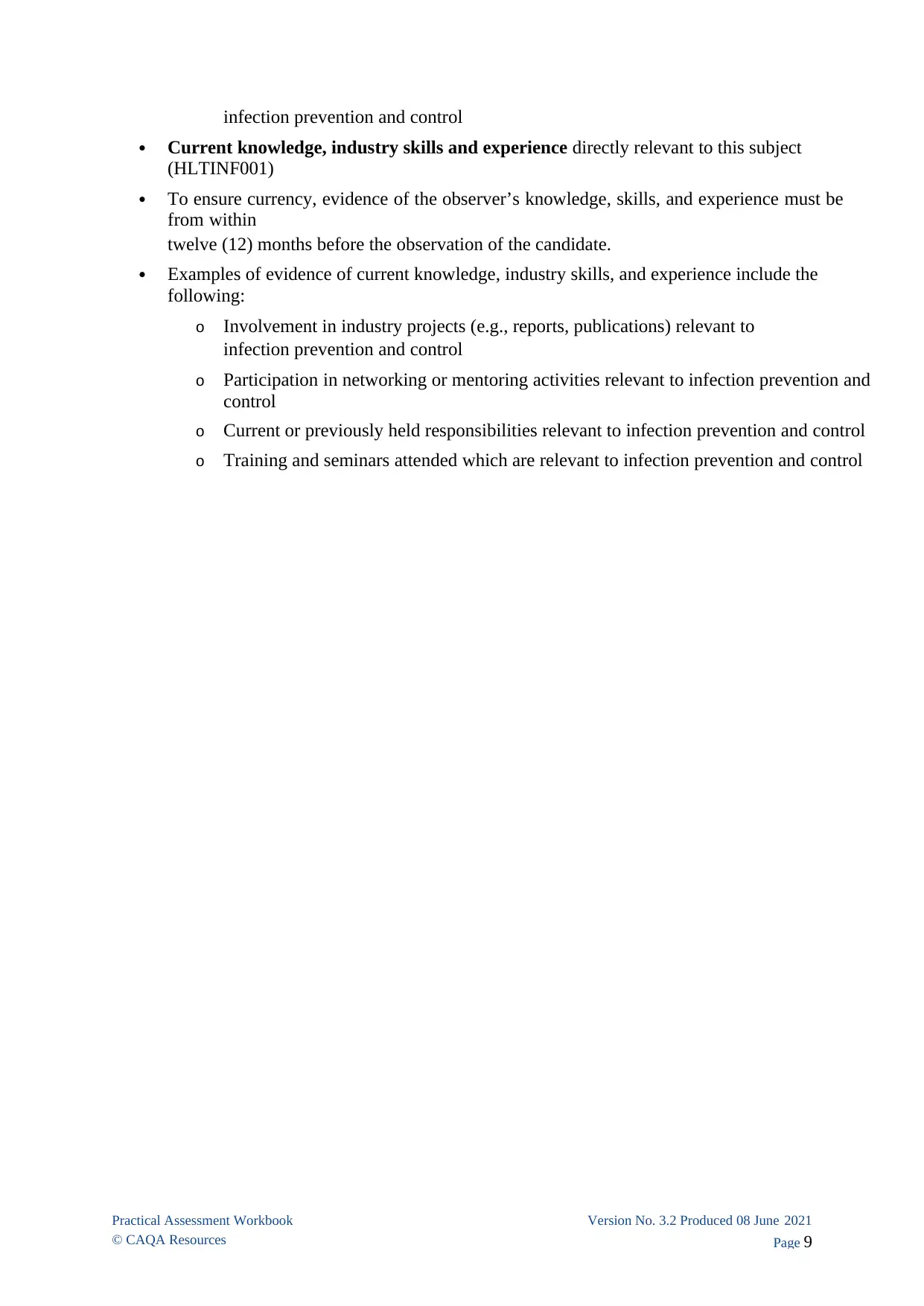
Practical Assessment Workbook
© CAQA Resources
Version No. 3.2 Produced 08 June 2021
Page 9
infection prevention and control
Current knowledge, industry skills and experience directly relevant to this subject
(HLTINF001)
To ensure currency, evidence of the observer’s knowledge, skills, and experience must be
from within
twelve (12) months before the observation of the candidate.
Examples of evidence of current knowledge, industry skills, and experience include the
following:
o Involvement in industry projects (e.g., reports, publications) relevant to
infection prevention and control
o Participation in networking or mentoring activities relevant to infection prevention and
control
o Current or previously held responsibilities relevant to infection prevention and control
o Training and seminars attended which are relevant to infection prevention and control
© CAQA Resources
Version No. 3.2 Produced 08 June 2021
Page 9
infection prevention and control
Current knowledge, industry skills and experience directly relevant to this subject
(HLTINF001)
To ensure currency, evidence of the observer’s knowledge, skills, and experience must be
from within
twelve (12) months before the observation of the candidate.
Examples of evidence of current knowledge, industry skills, and experience include the
following:
o Involvement in industry projects (e.g., reports, publications) relevant to
infection prevention and control
o Participation in networking or mentoring activities relevant to infection prevention and
control
o Current or previously held responsibilities relevant to infection prevention and control
o Training and seminars attended which are relevant to infection prevention and control
⊘ This is a preview!⊘
Do you want full access?
Subscribe today to unlock all pages.

Trusted by 1+ million students worldwide
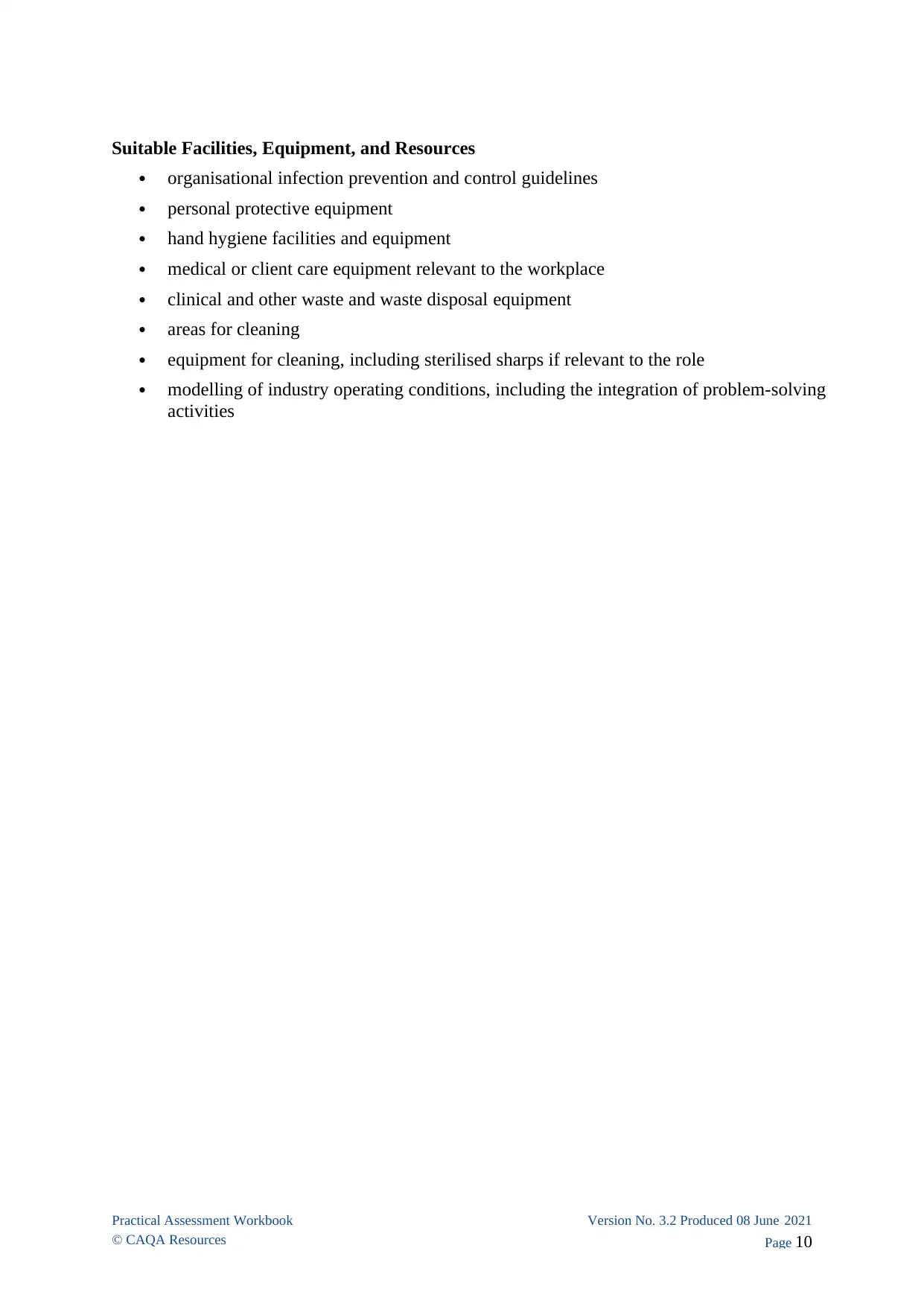
Practical Assessment Workbook
© CAQA Resources
Version No. 3.2 Produced 08 June 2021
Page 10
Suitable Facilities, Equipment, and Resources
organisational infection prevention and control guidelines
personal protective equipment
hand hygiene facilities and equipment
medical or client care equipment relevant to the workplace
clinical and other waste and waste disposal equipment
areas for cleaning
equipment for cleaning, including sterilised sharps if relevant to the role
modelling of industry operating conditions, including the integration of problem-solving
activities
© CAQA Resources
Version No. 3.2 Produced 08 June 2021
Page 10
Suitable Facilities, Equipment, and Resources
organisational infection prevention and control guidelines
personal protective equipment
hand hygiene facilities and equipment
medical or client care equipment relevant to the workplace
clinical and other waste and waste disposal equipment
areas for cleaning
equipment for cleaning, including sterilised sharps if relevant to the role
modelling of industry operating conditions, including the integration of problem-solving
activities
Paraphrase This Document
Need a fresh take? Get an instant paraphrase of this document with our AI Paraphraser
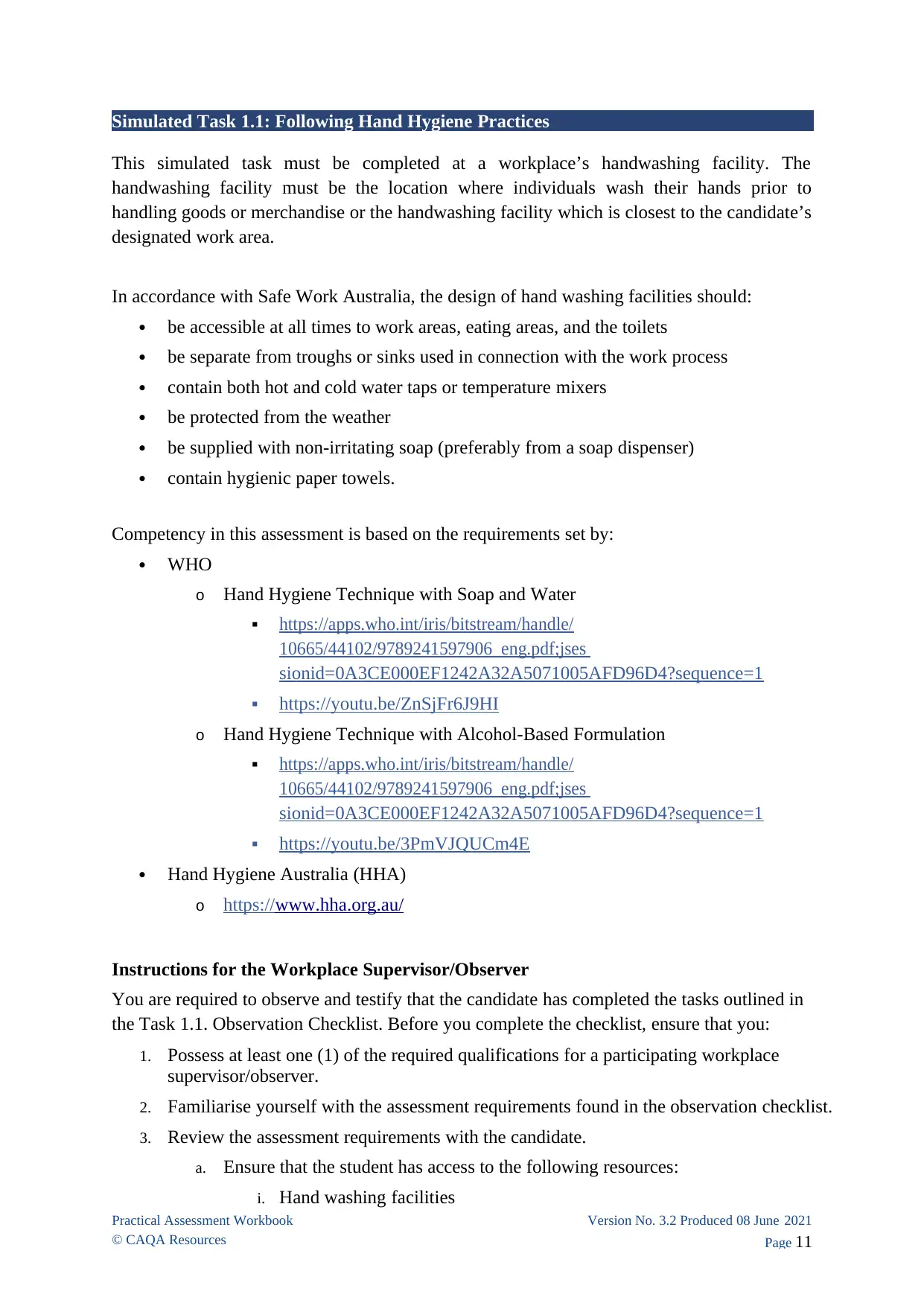
Practical Assessment Workbook
© CAQA Resources
Version No. 3.2 Produced 08 June 2021
Page 11
Simulated Task 1.1: Following Hand Hygiene Practices
This simulated task must be completed at a workplace’s handwashing facility. The
handwashing facility must be the location where individuals wash their hands prior to
handling goods or merchandise or the handwashing facility which is closest to the candidate’s
designated work area.
In accordance with Safe Work Australia, the design of hand washing facilities should:
be accessible at all times to work areas, eating areas, and the toilets
be separate from troughs or sinks used in connection with the work process
contain both hot and cold water taps or temperature mixers
be protected from the weather
be supplied with non-irritating soap (preferably from a soap dispenser)
contain hygienic paper towels.
Competency in this assessment is based on the requirements set by:
WHO
o Hand Hygiene Technique with Soap and Water
https://apps.who.int/iris/bitstream/handle/
10665/44102/9789241597906_eng.pdf;jses
sionid=0A3CE000EF1242A32A5071005AFD96D4?sequence=1
https://youtu.be/ZnSjFr6J9HI
o Hand Hygiene Technique with Alcohol-Based Formulation
https://apps.who.int/iris/bitstream/handle/
10665/44102/9789241597906_eng.pdf;jses
sionid=0A3CE000EF1242A32A5071005AFD96D4?sequence=1
https://youtu.be/3PmVJQUCm4E
Hand Hygiene Australia (HHA)
o https://www.hha.org.au/
Instructions for the Workplace Supervisor/Observer
You are required to observe and testify that the candidate has completed the tasks outlined in
the Task 1.1. Observation Checklist. Before you complete the checklist, ensure that you:
1. Possess at least one (1) of the required qualifications for a participating workplace
supervisor/observer.
2. Familiarise yourself with the assessment requirements found in the observation checklist.
3. Review the assessment requirements with the candidate.
a. Ensure that the student has access to the following resources:
i. Hand washing facilities
© CAQA Resources
Version No. 3.2 Produced 08 June 2021
Page 11
Simulated Task 1.1: Following Hand Hygiene Practices
This simulated task must be completed at a workplace’s handwashing facility. The
handwashing facility must be the location where individuals wash their hands prior to
handling goods or merchandise or the handwashing facility which is closest to the candidate’s
designated work area.
In accordance with Safe Work Australia, the design of hand washing facilities should:
be accessible at all times to work areas, eating areas, and the toilets
be separate from troughs or sinks used in connection with the work process
contain both hot and cold water taps or temperature mixers
be protected from the weather
be supplied with non-irritating soap (preferably from a soap dispenser)
contain hygienic paper towels.
Competency in this assessment is based on the requirements set by:
WHO
o Hand Hygiene Technique with Soap and Water
https://apps.who.int/iris/bitstream/handle/
10665/44102/9789241597906_eng.pdf;jses
sionid=0A3CE000EF1242A32A5071005AFD96D4?sequence=1
https://youtu.be/ZnSjFr6J9HI
o Hand Hygiene Technique with Alcohol-Based Formulation
https://apps.who.int/iris/bitstream/handle/
10665/44102/9789241597906_eng.pdf;jses
sionid=0A3CE000EF1242A32A5071005AFD96D4?sequence=1
https://youtu.be/3PmVJQUCm4E
Hand Hygiene Australia (HHA)
o https://www.hha.org.au/
Instructions for the Workplace Supervisor/Observer
You are required to observe and testify that the candidate has completed the tasks outlined in
the Task 1.1. Observation Checklist. Before you complete the checklist, ensure that you:
1. Possess at least one (1) of the required qualifications for a participating workplace
supervisor/observer.
2. Familiarise yourself with the assessment requirements found in the observation checklist.
3. Review the assessment requirements with the candidate.
a. Ensure that the student has access to the following resources:
i. Hand washing facilities
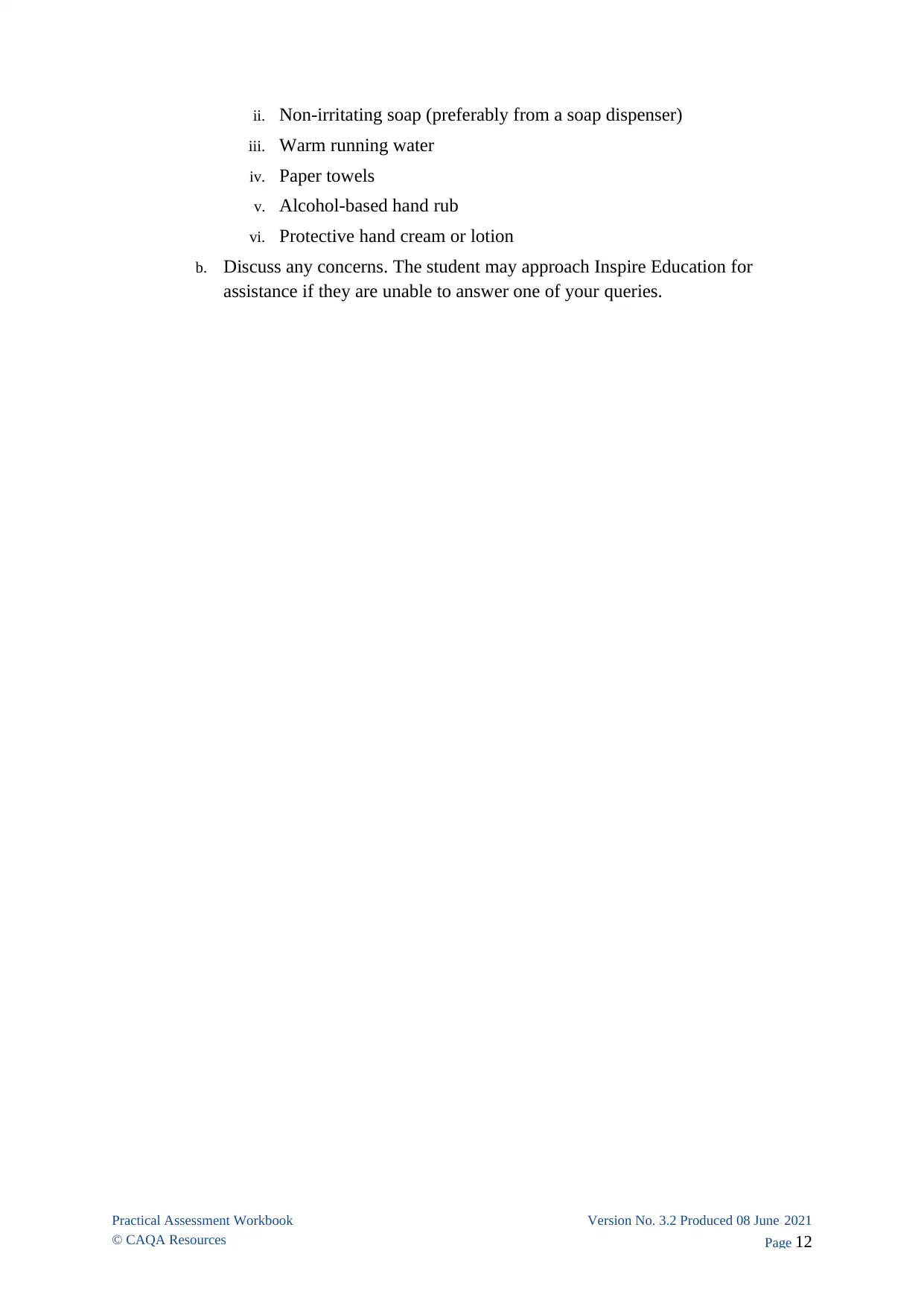
Practical Assessment Workbook
© CAQA Resources
Version No. 3.2 Produced 08 June 2021
Page 12
ii. Non-irritating soap (preferably from a soap dispenser)
iii. Warm running water
iv. Paper towels
v. Alcohol-based hand rub
vi. Protective hand cream or lotion
b. Discuss any concerns. The student may approach Inspire Education for
assistance if they are unable to answer one of your queries.
© CAQA Resources
Version No. 3.2 Produced 08 June 2021
Page 12
ii. Non-irritating soap (preferably from a soap dispenser)
iii. Warm running water
iv. Paper towels
v. Alcohol-based hand rub
vi. Protective hand cream or lotion
b. Discuss any concerns. The student may approach Inspire Education for
assistance if they are unable to answer one of your queries.
⊘ This is a preview!⊘
Do you want full access?
Subscribe today to unlock all pages.

Trusted by 1+ million students worldwide
1 out of 90
Related Documents
Your All-in-One AI-Powered Toolkit for Academic Success.
+13062052269
info@desklib.com
Available 24*7 on WhatsApp / Email
![[object Object]](/_next/static/media/star-bottom.7253800d.svg)
Unlock your academic potential
Copyright © 2020–2025 A2Z Services. All Rights Reserved. Developed and managed by ZUCOL.




